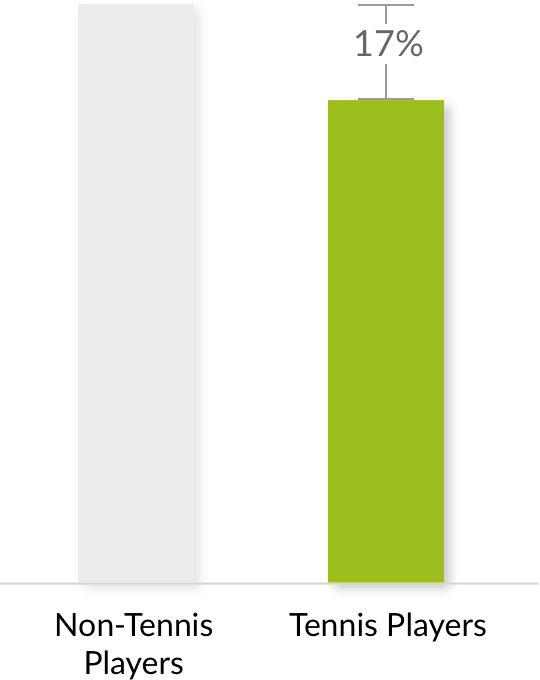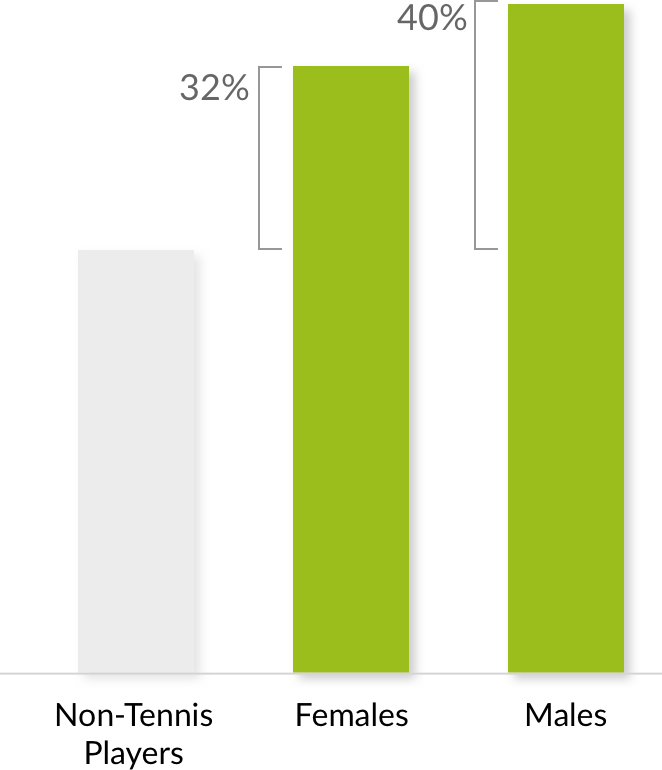
 Tennis & Cardiovascular Disease
Tennis & Cardiovascular Disease
Participation in tennis or other racquet sports can significantly lower risk of death from heart disease by 59%, according to a 2017 article in the British Journal Of Sports Medicine.
The 2017 study, published in the British Journal of Sports Medicine, studied the associations of six different types of sport/exercise with all-cause and cardiovascular disease (CVD) mortality risk in a large pooled Scottish and English population-based cohort of 80,306 individuals (54% women; mean ± SD age: 52 ± 14 years). Selection of covariates was guided by previous literature adjustments made for age, sex, long-standing illness, alcohol drinking frequency, psychological distress, BMI, smoking status, education level, doctor-diagnosed CVD (all-cause mortality analyses only) and weekly physical activity volume (MET-hours/week excluding the volume of the sport that was the main exposure in the corresponding model). Participants who had doctor-diagnosed CVD at baseline (angina, stroke, IHD) were excluded from the analyses with CVD mortality as outcome. Cox proportional hazards regression was used to investigate the associations between each exposure and all-cause and CVD mortality and after adjustments a significant risk reduction of 59% for CVD mortality was observed for participation in racquet sports, including tennis.
Oja et al Br J Sports Med (2017)

Tennis & Cardiovascular Disease
Participation in tennis or other racquet sports can significantly lower risk of death from heart disease by 59%, according to a 2017 article in the British Journal Of Sports Medicine.
The 2017 study, published in the British Journal of Sports Medicine, studied the associations of six different types of sport/exercise with all-cause and cardiovascular disease (CVD) mortality risk in a large pooled Scottish and English population-based cohort of 80,306 individuals (54% women; mean±SD age: 52±14 years). Selection of covariates was guided by previous literature adjustments made for age, sex, long-standing illness, alcohol drinking frequency, psychological distress, BMI, smoking status, education level, doctor-diagnosed CVD (all-cause mortality analyses only) and weekly physical activity volume (MET-hours/week excluding the volume of the sport that was the main exposure in the corresponding model). Participants who had doctor-diagnosed CVD at baseline (angina, stroke, IHD) were excluded from the analyses with CVD mortality as outcome. Cox proportional hazards regression was used to investigate the associations between each exposure and all-cause and CVD mortality and after adjustments a significant risk reduction of 59% for CVD mortality was observed for participation in racquet sports, including tennis.
Oja et al Br J Sports Med (2017)
 Tennis & Body Fat
Tennis & Body Fat
According to a 2007 study in the British Journal of Sports Medicine, tennis players who play twice a week have 17% lower body fat than the age matched controls.
The aim of the study was to explore the role of tennis in the promotion of health and prevention of disease. The focus was on risk factors and diseases related to a sedentary lifestyle, including low fitness levels, obesity, hyperlipidaemia, hypertension, diabetes mellitus, cardiovascular disease, and osteoporosis. A literature search was undertaken to retrieve relevant articles. People who choose to play tennis appear to have significant health benefits, including improved aerobic fitness, a lower body fat percentage, a more favourable lipid profile, reduced risk for developing cardiovascular disease, and improved bone health.
Pluim BM, Staal JB, Marks BL, Miller S, Miley D. Health benefits of tennis. British Journal of Sports Medicine. 2007;41(11):760-768. doi:10.1136/bjsm.2006.034967.

Tennis & Body Fat
 Tennis & HDL Cholesterol
Tennis & HDL Cholesterol
According to a renowned study in Metabolism, HDL (“the good cholesterol”) is 16% higher in male tennis players and 11% higher for female players.
Fasting plasma lipid and lipoprotein concentrations were determined in 25 men and 25 women (mean ages 42 and 39 yr respectively) whose exclusive mode of regular exercise was tennis play. When compared to a sedentary group matched for age, sex, and education, the tennis players exhibited similar plasma total cholesterol and LDL-cholesterol concentrations and significantly lower triglyceride and VLDL-cholesterol concentrations. HDL-cholesterol was significantly higher in the tennis players. It is concluded that frequent tennis playing is associated with increased HDL-cholesterol concentrations and that this relationship is independent of other factors known to alter plasma HDL-cholesterol concentration.
Vodak PA, Wood PD, Haskell WL, et al. Metabolism 1980;29:745–52

Tennis & HDL Cholesterol
According to a renowned study in Metabolism, HDL (“the good cholesterol”) is 16% higher in male tennis players and 11% higher for female players.
Fasting plasma lipid and lipoprotein concentrations were determined in 25 men and 25 women (mean ages 42 and 39 yr respectively) whose exclusive mode of regular exercise was tennis play. When compared to a sedentary group matched for age, sex, and education, the tennis players exhibited similar plasma total cholesterol and LDL-cholesterol concentrations and significantly lower triglyceride and VLDL-cholesterol concentrations. HDL-cholesterol was significantly higher in the tennis players. It is concluded that frequent tennis playing is associated with increased HDL-cholesterol concentrations and that this relationship is independent of other factors known to alter plasma HDL-cholesterol concentration.
Vodak PA, Wood PD, Haskell WL, et al. Metabolism 1980;29:745–52
 Tennis & VO2 Max
Tennis & VO2 Max
According to a 1980 study in the Journal of Medicine and Science in Sports and Exercise, average VO2 max is 40% higher for male tennis players and 32% higher for females.
Cardiorespiratory characteristics, relative body fat, grip strength and selected skinfolds, circumferences and bone diameters were determined in 25 males and 25 females (31--55 year) whose exclusive mode of regular exercise was tennis (9.7--11.1 hours per week). Mean resting heart rates were 54 beats per minute for the males and 61 beats per minute for the females. Compared to normally active populations of the same age and sex, the tennis players displayed an above average maximal oxygen uptake, below average relative body fat, greater dominant grip strengths, and similar non-dominant grip strengths. The results indicate that either physically superior individuals choose to play tennis, or that regular tennis participation produces above average levels of fitness, or both.
Vodak PA et al. Med Sci Sports Exerc. 1980;12(3):159-63.

Tennis & VO2 Max


We are a licensed life insurance agent* in all 50 states.
View our licenses
We negotiated lower rates on life insurance using science and data.
View our research
By tennis players for tennis players. Our team is comprised of health conscious people who overcame their own health challenges with healthy habits, exercise, and nutrition.
Meet our team














